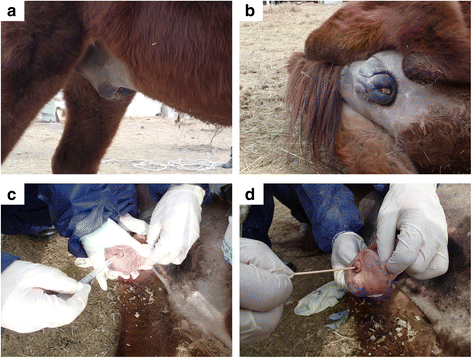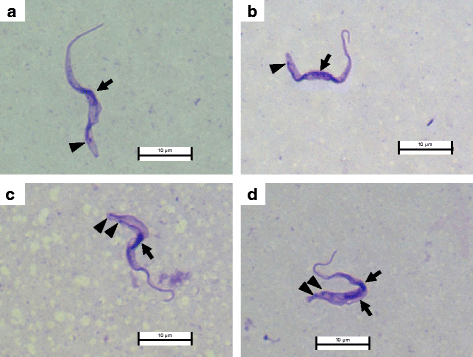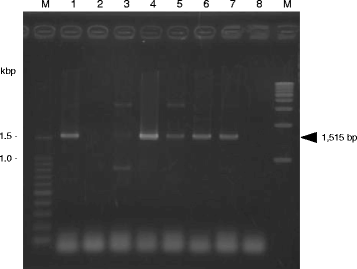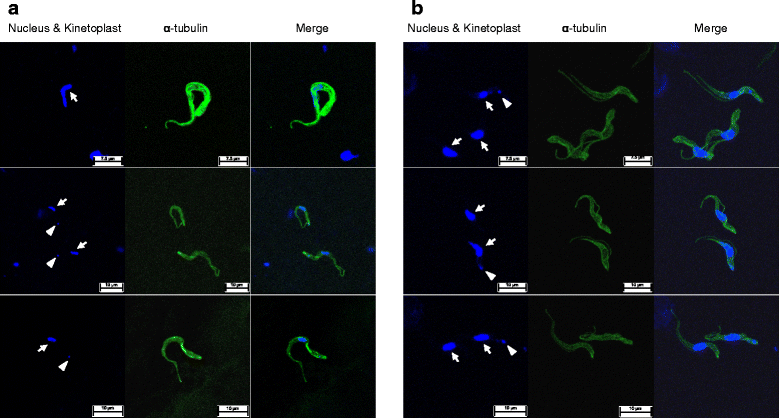Isolation, cultivation and molecular characterization of a new Trypanosoma equiperdum strain in Mongolia
- PMID: 27580944
- PMCID: PMC5007690
- DOI: 10.1186/s13071-016-1755-3
Isolation, cultivation and molecular characterization of a new Trypanosoma equiperdum strain in Mongolia
Abstract
Background: Trypanosoma equiperdum causes dourine via sexual transmission in Equidae. T. equiperdum is classified under the subgenus Trypanozoon along with the T. brucei sspp. and T. evansi; however, the species classification of Trypanozoon remains a controversial topic due to the limited number of T. equiperdum reference strains. In addition, it is possible that some were misclassified T. evansi strains. Thus, there is a strong need for a new T. equiperdum strain directly isolated from the genital mucosa of a horse with a clinically- and parasitologically-confirmed dourine infection.
Methods: Trypanosomes isolated from the urethral tract of a stallion with suspected dourine, were directly cultivated using soft agarose media at 37 °C in 5 % CO2. For molecular characterization, 18S ribosomal RNA (rRNA) gene, the internal transcribed spacer (ITS) and 8 maxicircle DNA regions were amplified by a PCR and their sequences were determined. To analyze the ratio of the kinetoplastic/akinetoplastic population, the kinetoplasts and the nuclei of trypanosomes were subjected to Hoechst staining and observed by fluorescence microscopy.
Results: In addition to the clinical symptoms and the molecular diagnosis, this stallion was definitively diagnosed with dourine by the detection of trypanosomes in the urethral mucosa. These results strongly suggested that the isolated trypanosome was true T. equiperdum. T. equiperdum isolated from the urethral tract was adapted in vitro using soft agarose media. Based on the results of a phylogenetic analysis of 18S rRNA and ITS, this T. equiperdum isolate was classified into the Trypanozoon clade. In a PCR of the maxicircle DNA region, only NADH-dehydrogenase subunits 4 and 5 was amplified. Clear kinetoplasts were observed in most of the T. equiperdum isolates. In contrast, most culture-adapted T. equiperdum were of the akinetoplastic form.
Conclusion: We concluded that our isolated trypanosome was the first confirmed case of T. equiperdum in Mongolia and named it "T. equiperdum IVM-t1". T. equiperdum IVM-t1 was well adapted and propagated in soft agarose media, which indicates that this culture method is useful for isolation of T. equiperdum from horses with dourine.
Keywords: Dourine; In vitro culture; Maxicircle DNA; Mongolia; Soft agarose media; Trypanosoma equiperdum.
Figures




Similar articles
-
Molecular characterization and classification of Trypanosoma spp. Venezuelan isolates based on microsatellite markers and kinetoplast maxicircle genes.Parasit Vectors. 2015 Oct 15;8:536. doi: 10.1186/s13071-015-1129-2. Parasit Vectors. 2015. PMID: 26467019 Free PMC article.
-
A field study to estimate the prevalence of Trypanosoma equiperdum in Mongolian horses.Vet Parasitol. 2003 Jul 10;115(1):9-18. doi: 10.1016/s0304-4017(03)00160-2. Vet Parasitol. 2003. PMID: 12860063
-
The current challenges of dourine: difficulties in differentiating Trypanosoma equiperdum within the subgenus Trypanozoon.Rev Sci Tech. 2003 Dec;22(3):1087-96. doi: 10.20506/rst.22.3.1460. Rev Sci Tech. 2003. PMID: 15005565 Review.
-
The evaluation of GM6-based ELISA and ICT as diagnostic methods on a Mongolian farm with an outbreak of non-tsetse transmitted horse trypanosomosis.Vet Parasitol. 2017 Sep 15;244:123-128. doi: 10.1016/j.vetpar.2017.07.036. Epub 2017 Aug 2. Vet Parasitol. 2017. PMID: 28917303
-
Trypanosoma equiperdum: master of disguise or historical mistake?Trends Parasitol. 2005 Jul;21(7):316-21. doi: 10.1016/j.pt.2005.05.010. Trends Parasitol. 2005. PMID: 15923142 Review.
Cited by
-
Sustainable Elimination (Zero Cases) of Sleeping Sickness: How Far Are We from Achieving This Goal?Pathogens. 2019 Aug 29;8(3):135. doi: 10.3390/pathogens8030135. Pathogens. 2019. PMID: 31470522 Free PMC article. Review.
-
European Inter-Laboratory Proficiency Test for Dourine Antibody Detection Using the Complement Fixation Test.Vet Sci. 2023 Sep 26;10(10):592. doi: 10.3390/vetsci10100592. Vet Sci. 2023. PMID: 37888544 Free PMC article.
-
The utility of an rTeGM6-4r-based immunochromatographic test for the serological diagnosis of non-tsetse-transmitted equine trypanosomosis in rural areas of Mongolia.Parasitol Res. 2018 Sep;117(9):2913-2919. doi: 10.1007/s00436-018-5982-8. Epub 2018 Jun 25. Parasitol Res. 2018. PMID: 29943319
-
Equine trypanosomosis: enigmas and diagnostic challenges.Parasit Vectors. 2019 May 15;12(1):234. doi: 10.1186/s13071-019-3484-x. Parasit Vectors. 2019. PMID: 31092285 Free PMC article. Review.
-
Biological activity evaluations of chemical constituents derived from Mongolian medicinal forage plants and their applications in combating infectious diseases and addressing health problems in humans and livestock.J Nat Med. 2021 Sep;75(4):729-740. doi: 10.1007/s11418-021-01529-7. Epub 2021 May 21. J Nat Med. 2021. PMID: 34018093 Free PMC article. Review.
References
Publication types
MeSH terms
LinkOut - more resources
Full Text Sources
Other Literature Sources
Medical

